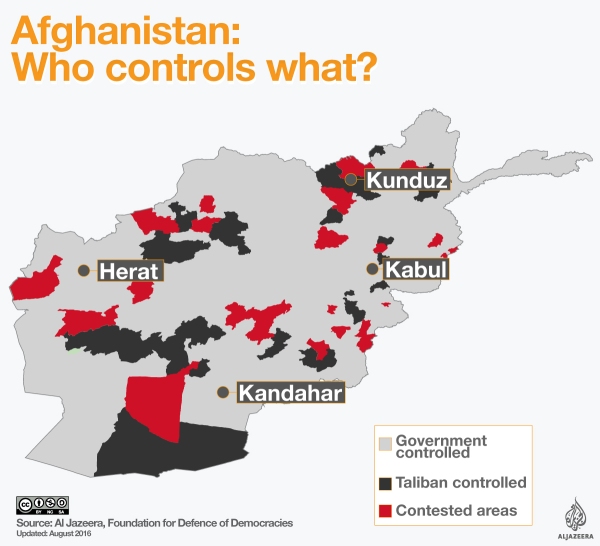To what extent do the Taliban “control” Afghanistan…?
Summary: maps are helpful guides for highlighting the continued struggle that the Afghan government has with the Taliban. However caution is needed in trying to understand a fluid situation. There is minimal prospect of peace dialogue. Neither are there any signs of critical stresses in the government. The war continues.

2016
I have seen versions of this map for some years. Unfortunately this map does not give particularly good granularity, lacking province and district details. It gives no methodology. Although the standard recurrent theme is the difficulty that Helmand and Kandahar are under, I was a little surprised that the south east and east – Nangarhar, for example, do not show up more strongly as “contested” areas. It does highlight the significant pressure that Konduz in the north is under (and has been for the last year). But it is probably best to be cautious with the use of terminology when it comes to “control” of a province or district. Generally government forces have control over the major population centres and the main highways, while having to yield to Taliban influence in farther flung, more rural, areas – the bottom halves of Kandahar and Helmand do not have much in the way of population, towns or commerce.

2015: More alarmist? Source: New York Times/Institute for the Study of War
The insurgents have appointed “shadow” governors to all Afghan provinces and attempt to exert their own rule of law and instructions where they can. But the security situation is quite fluid: Taliban group can dominate particular routes, towns and villages over prolonged periods, simply by setting up a few checkpoints or mobile Sharia courts, without necessarily formally controlling a district.
Conversely, government forces often define “control” of a village or district simply by the fact that they having their flag planted on the roof of the police or local government headquarters. If we stacked these maps together in date order, it is perhaps even possible to argue that the situation is improving. Caution is needed as there are very different terminologies and defintions.
There remains minimal prospect of peace dialogue between Taliban and government any time soon. But neither are there any signs of critical stresses in the government. The stalemate continues.


how great is the taliban influence in Shirabat?